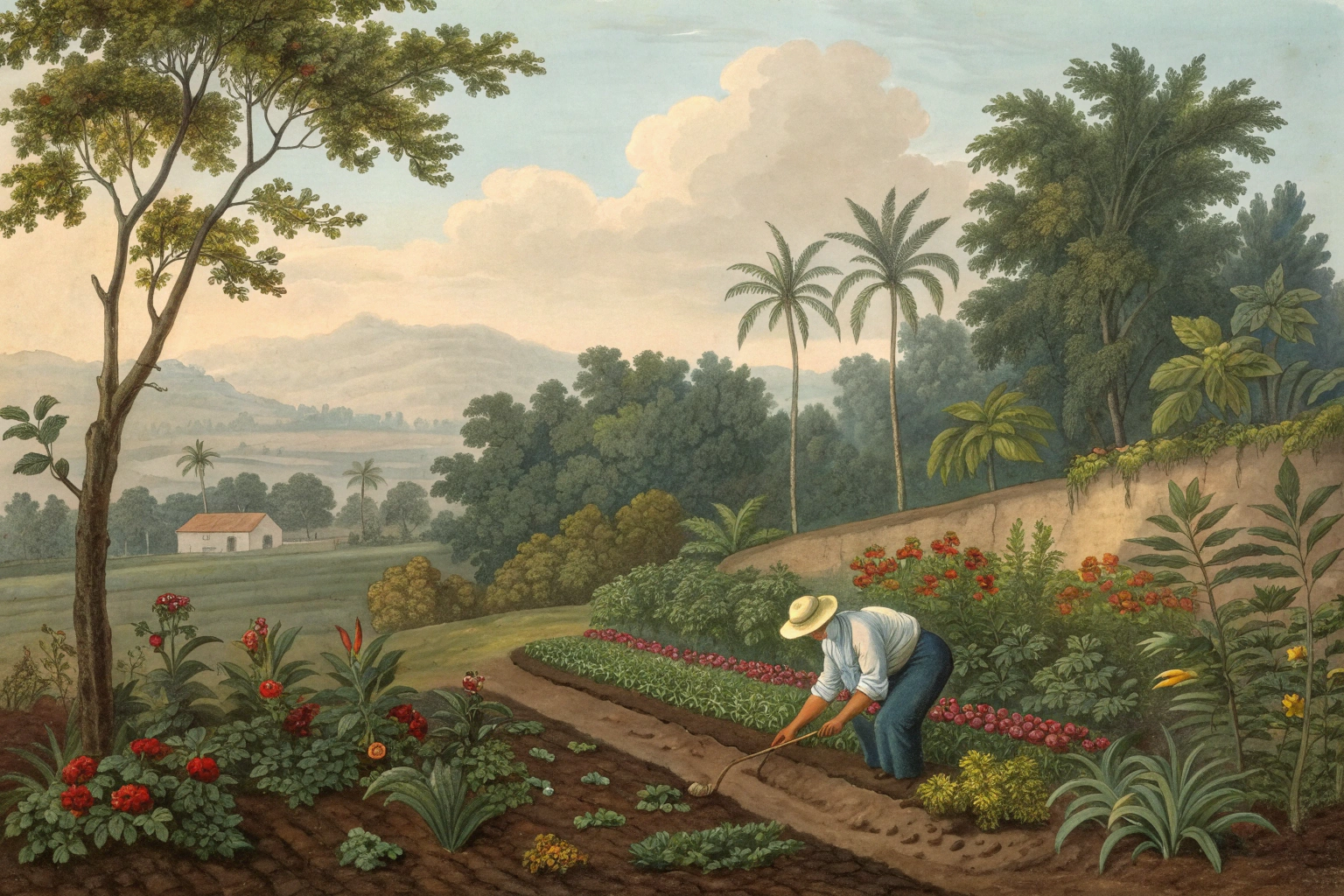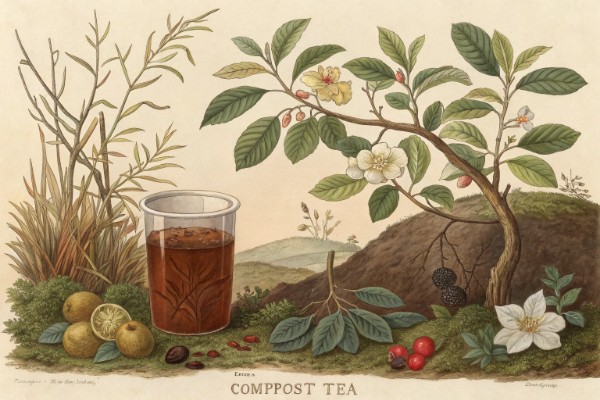Biochar in the Garden: What It Is and How It Transforms Your Soil

Biochar soil improvement
Biochar soil improvement boosts water retention, CEC, and microbe habitat; mix 5–10% by volume. For biochar soil improvement, pre-charge with compost tea or fish emulsion to curb nitrogen drawdown. Blend into the top 4–6 in (10–15 cm) of soil; biochar soil improvement persists for decades as stable carbon. Stick around for simple steps, field-tested ratios, and the gritty science that makes beds run like a kitchen line.
Cheatsheet: Fast-Track Biochar Soil Boost
🌱 Benefits at a Glance
- Up to 50% better soil water retention
- Boosts microbial life and root growth
- Reduces fertilizer needs by 20-40%
- Enhances crop yields and plant health
- Locks in carbon for 1000+ years
- Improves self-sufficiency and homegrown nutrition
🛠️ Tools and Products You'll Need
- Raw biochar or ready-to-use biochar
- Organic compost or worm castings
- Watering can or hose
- Wheelbarrow or large bucket
- Shovel or garden fork
- Gloves and dust mask (for safety)
🔥 Preparing Biochar for Soil
- Do not use raw biochar directly. It can absorb soil nutrients.
- "Charge" biochar: Mix with compost or worm castings and moist soil for 1-7 days. Alternatively, soak in liquid fertilizer or compost tea 24-72 hours.
- Aim for 1:1 ratio biochar to compost by volume for best results.
🌾 Application Steps
- Spread charged biochar mix over target soil at 0.5-1 inch (1.2-2.5 cm) depth.
- Mix into top 6-8 inches (15-20 cm) of soil using a fork or tiller.
- Water well to activate soil microbiology.
- Start planting after 1-2 days, or let soil rest up to a week for best integration.
💡 Tips for Best Results
- Use 5-10% biochar by volume. More may raise soil pH.
- Combine with organic matter for ongoing fertility.
- Test soil pH before and after; adjust with sulfur or lime as needed.
🌍 Sustainability Impact
- 1 lb (0.45 kg) biochar can offset up to 3 lbs (1.36 kg) CO₂
- Helps grow nutrient-dense produce at home
- Builds resilience for food security
Biochar in plain language
Biochar is charcoal made from plant matter under low oxygen, a process called pyrolysis, and it acts like a long-lived sponge for soil life and nutrients.
Think of the Amazon’s dark earths, Terra Preta, where carbon-rich amendments were buried centuries ago and still feed crops today.
How it transforms soil
Those jet-black particles carry labyrinthine pores, a huge internal surface area, and sites that hold nutrients by electrostatic attraction known as cation exchange.
In practice, this means better water retention in sandy beds, gentler structure in clays, steadier pH in acidic ground, and fewer nutrients washing away after rain.
What the data says
- Average crop yield bumps near 10 percent across studies, with stronger gains on acidic or sandy soils (Jeffery et al., 2017, Global Change Biology Bioenergy).
- Large cuts in nitrous oxide emissions from soil, often around 30 to 50 percent in trials, which matters for climate and nitrogen efficiency (Cayuela et al., 2014, Agriculture, Ecosystems & Environment).
- Water holding rises in coarse soils by double digits, frequently 15 to 30 percent, in USDA-ARS research summaries.
- Carbon stays put for centuries, with 1 ton of biochar locking roughly 2 to 3 tons CO2e depending on feedstock and system boundaries (International Biochar Initiative).
“Biochar is a carbon-rich product obtained by thermal decomposition of biomass in a limited oxygen supply,” Lehmann and Joseph wrote, noting its stability and porous architecture that favors soil microbes. (Biochar for Environmental Management, 2nd ed.)
What I see in real beds
In my sandiest trial plot, a 5 percent biochar blend turned mid-July irrigation from daily to every second or third day, and basil stopped sulking between waterings.
On a heavy clay row, the spring crust eased, earthworms moved in, and transplanting no longer felt like chiseling concrete.
Biochar soil improvement, step by step
Charge it first
Raw biochar can soak up nutrients like a hungry pumice stone, so I pre-load it with a nitrogen-rich liquid and microbes before it hits the ground.
Soak 1 part biochar in 1 to 2 parts compost tea, fish hydrolysate solution, diluted urine, or actively aerated compost extract for 1 to 2 weeks, then drain and mix.
Rates that work
For in-ground beds, blend 5 to 10 percent by volume into the top 4 to 6 inches, or apply 2 to 5 liters per square meter, then water deeply.
For potting mixes, I run 10 to 20 percent biochar by volume paired with quality compost and a slow-release organic fertilizer, which steadies moisture and pH.
Timing and pairing
Fold it in during bed prep with compost and a nitrogen source, then top up at 1 to 2 liters per square meter in following seasons as you build a living soil pantry.
Once the pores are colonized, the char behaves like durable habitat that rides along for years with your mulch and compost program.
What to buy and why
Feedstock matters, firing temperature matters, and testing matters, because ash content, pH, and contaminants vary widely.
Look for third-party certification, low PAHs, documented heavy metal tests, a pH profile, and a particle size between 1 and 10 millimeters for garden use.
Top picks for different uses
- Pre-inoculated biochar plus compost blend: easy on-ramp for raised beds and new growers.
- Wood-derived, high-temperature biochar with low ash: reliable choice for vegetables and flowers.
- Fine-screened biochar for seedling mixes: improves aeration while staying evenly distributed.
- Specialty blends for acid-lovers: lower-ash char or co-composted char to avoid pushing pH too high for blueberries and azaleas.
- Horticultural charcoal vs. biochar: both are chars, but garden-grade biochar comes with soil-use specs and testing, which I prefer.
Price, value, and where it pencils out
Retail usually sits around 20 to 40 USD per cubic foot, 0.7 to 1.4 USD per liter, with bulk yard pricing 500 to 900 USD per cubic yard, often similar in EUR depending on shipping.
In my water-thirsty beds, that spend paid back with less irrigation and fewer fertilizer losses, and I got steadier yields during hot spells.
DIY without drama
Use clean, untreated dry feedstock and run a cone kiln, TLUD stove, or trench burn that limits oxygen, then quench hard with water or finished compost.
Pyrolysis sweet spot lands near 932 to 1112 F, 500 to 600 C, which keeps tar low and preserves structure, then remember to charge the char before soil contact.
Soil-by-soil tips
- Sandy soils: biochar plus compost curbs leaching, reduces watering, and steadies potassium and calcium availability.
- Clay soils: mix biochar with compost to open the matrix and improve infiltration, then mulch to protect the aggregation you create.
- Acid soils: wood char often raises pH slightly, which can help brassicas and alliums; test first and avoid overdoing it with ashes.
- Alkaline soils: choose lower-ash char, skip lime, and lean on sulfur or acidic compost if you need to correct pH.
- Saline or reclaimed soils: pre-soak and rinse char, then blend with high-quality compost to buffer salts.
- Containers: 10 to 20 percent char improves drainage and resilience during heat waves, especially with coco coir or bark fines.
Common mistakes I see
- Applying raw, uncharged char that ties up nitrogen for a few weeks.
- Confusing ash with biochar, since ash is mostly minerals and can spike pH fast.
- Grinding to dust and breathing it in, or creating hydrophobic fines that shed water.
- Using feedstock contaminated with paint, preservatives, or plastics.
- Overapplication that overshoots pH for acid-loving crops.
- Expecting overnight miracles instead of steady gains over seasons.
Microbes, fungi, and the black scaffold
I see faster mycorrhizal colonization where biochar and compost meet, likely because the pores give hyphae and bacteria protected lodging.
Pair char with fungal-dominant compost under a wood chip mulch and watch perennials settle into a calmer, less thirsty rhythm.
Compost synergy that pays
Mixing fresh biochar into a compost pile during thermophilic phases can cut ammonia smells and keep nitrogen from gassing off.
By the time that pile cools, the char is charged and cloaked in humic substances, which spreads beautifully and resists wind drift.
Quality, safety, and certification
Reputable suppliers share lab sheets on pH, ash, PAHs, and metals, and many carry IBI or EBC labels along with OMRI listings for organic systems.
I still run a quick soil test before and after first-year use, then adjust rates so pH and cation balance land where the crop wants them.
Numbers gardeners ask me for
- Starting rate: 2 to 5 liters per square meter in beds, 10 to 20 percent in potting mixes.
- Top-up cadence: 1 to 2 liters per square meter yearly with compost until soil tilth and water behavior feel dialed in.
- Particle size: 1 to 10 millimeters for beds, finer for seedling mixes.
- Target pH of char: neutral to slightly alkaline, 7 to 9, unless you are growing acid-lovers.
Quotes, stats, and where to read more
Meta-analyses point to mean yield gains around 10 percent and stronger responses in low-fertility, acidic soils. (Jeffery et al., 2017)
Reported median nitrous oxide cuts often fall near 40 to 50 percent in controlled studies, with field results varying by soil and moisture. (Cayuela et al., 2014)
Practical guides and factsheets: Cornell CALS Biochar FAQ, International Biochar Initiative, USDA-ARS soil health notes, and Lehmann and Joseph’s Biochar for Environmental Management.
I trust suppliers who publish batch tests and keep feedstock clean, since that transparency saves guesswork in the garden and keeps biochar soil improvement on track.

Want smarter plant choices? 🪴
Biochar Soil Improvement: Frequently Asked Questions
How does biochar improve soil structure?
Biochar creates a porous matrix in the soil, increasing airflow and water retention. The intricate network of pores helps prevent compaction, improves drainage, and supports beneficial microbial communities. These physical changes foster plant roots and encourage healthier growth.
Will biochar change soil pH?
Many biochar soil amendments bring a mildly alkaline effect, especially if produced at higher temperatures (over 932°F or 500°C). This may slightly raise the pH of acidic soils, creating a more balanced environment for plant uptake of nutrients. Always test soil before and after application for any needed adjustments.
Should I apply biochar directly, or does it need to be charged first?
Applying raw biochar can temporarily draw nutrients from the soil. For best results, pre-load or “charge” it with compost, worm castings, or liquid fertilizers before mixing it into your garden beds. This process ensures nutrients remain readily available for plants and speeds up biochar soil improvement.
How long does it take to see benefits from biochar soil improvement?
Some gardeners notice positive changes within a few months, especially in moisture holding and root development. Long-term effects build over years, as biochar slowly integrates and continues supporting beneficial soil life, nutrient cycles, and stable organic matter.
Can biochar be used in any type of soil?
Biochar soil improvement works especially well in sandy or clay-heavy soils. In sandy soils, biochar holds water and nutrients that would otherwise wash away. In clay-rich soils, the porous structure opens up dense layers, improving texture. Always tailor the amount and preparation method to your specific soil type.
What is the best way to apply biochar to an established garden?
In established beds, gently mix biochar (pre-charged for best effect) into the top 4 to 6 inches (10 to 15 centimeters) of soil. This can be done alongside seasonal compost applications. Avoid heavy concentration in planting holes, as even distribution encourages uniform soil improvement.
Biochar pays off when you keep it simple. For real biochar soil improvement, charge it with finished compost or a nutrient-rich brew, then mix about 5 to 10 percent into the top few inches. Those carbon pores bank nutrients, boost water retention, and host microbial life. Expect steadier moisture, fewer nutrient losses, and soil that handles roots cleanly. Start small, observe, adjust.
Fold biochar into a wider soil plan: compost cycles, nitrogen-fixing plants, and thoughtful companion planting. If your beds run acidic, you can temper them over time with eggshells, and keep an eye on pH. Give biochar time. It works quietly, season after season, turning waste wood into long-lived structure and steady fertility. No magic, just good habits.
The Homesteader’s Method: Biochar for Deep Soil Health
Homesteaders pursue soil amendments with a sharp eye on budget, local resources, and long-term output. Biochar, made from simple waste streams and backyard ingenuity, aligns with resourcefulness and self-sufficiency. Field trials show biochar increases maize yields by 20-40% in poor soils—no synthetic inputs required.
Safe Backyard Production
- Convert pruned branches, corn cobs, and wood scraps to biochar via low-oxygen burns (pyrolysis). Use a metal drum or pit. Target 900–1100°F (480–600°C) for optimal carbonization.
- Quench hot char with water to halt combustion. Shovel out and store only after extinguished and cool.
- Always use a mask and gloves. Avoid plastics, painted, or treated wood. These release dangerous toxins and persistent pollutants.
Simple Pre-Charging for Results
- Biochar’s raw form draws up soil nutrients at first. Pre-load with homemade compost, manure slurry, or urine for 7–14 days.
- Mix char with compost in a 1:1 ratio, or soak char in diluted urine for twice as long, stirring daily.
Soil Application Timing and Dosage
- Apply char to vegetable beds in late fall or early spring. Work into top 4–6 in (10–15 cm) of soil at a rate of 2–5% by volume. Example: 2.5 gal (9.5 L) per 4x8 ft (1.2x2.4 m) bed.
- Layer under perennial fruit bushes to reduce nutrient leaching and increase drought resilience.
Health and Nutrition Upsides
- Biochar increases soil’s cation exchange, locking up heavy metals while releasing needed potassium, magnesium, and calcium.
- Harvested produce may contain up to 17% more calcium and 10% more magnesium, contributing to better nutrition with every meal.
Resource Stacking
- Save on purchased amendments. Biochar’s effects persist for centuries, reducing fertilizer inputs by 30–50% in successive years.
- Improves water retention up to 18% in sandy soils, cutting irrigation costs.
- Store carbon permanently in your property’s soil, with estimates suggesting every barrel of biochar locks up 250 lbs (113 kg) of atmospheric CO2 equivalents.
Find out which plants will thrive in your garden!
Answer a few fun questions and get custom plant recommendations perfect for your space. Let’s grow something amazing together!

start your season





